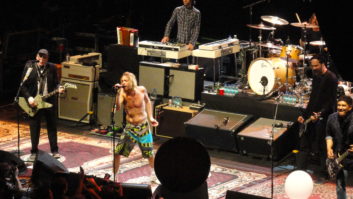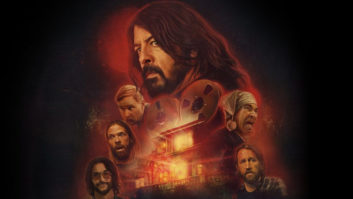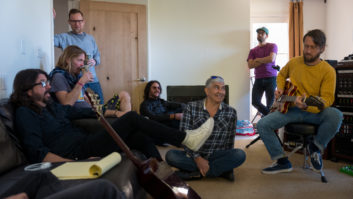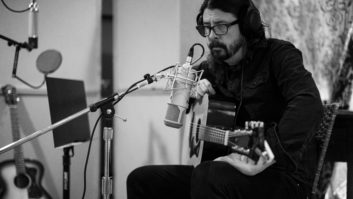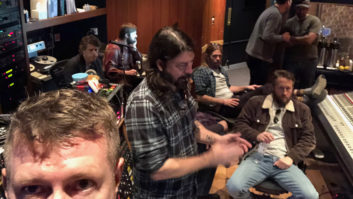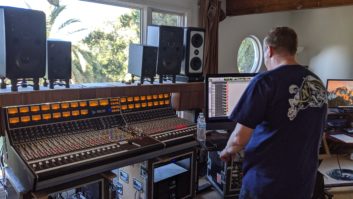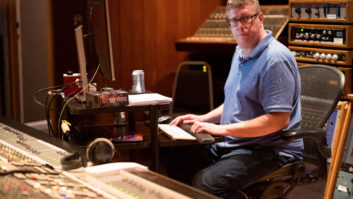
Not many performers have won a Grammy Award™ while playing for different bands, let alone playing different instruments in those bands, but Dave Grohl accomplished that feat when the Foo Fighters won the Best Rock Album Grammy in 2001 for There is Nothing Left to Lose. Grohl, guitarist and main vocalist of the Foo Fighters, had previously won a Grammy as drummer with Nirvana in 1996 for MTV Unplugged in New York in the Best Alternative Album category. The current incarnation of the Foo Fighters includes Grohl, guitarist Chris Shiflett, bassist Nate Mendel and drummer Taylor Hawkins. Their latest CD, One By One, has garnered rave reviews, and their spring tour has brought out enthusiastic crowds for the band’s energetic live shows. The band’s hard rock/punk sensibility is reflected in the mixing approach of FOH engineer Bryan Worthen.
“I have a lot of effects up here, but I don’t use them,” says Worthen. “It’s just added noise. I like keeping things as simple as possible. The Foo Fighters sound amazing just the way they are. Why add noisy effects to that sound?”

Worthen has been doing sound for more than 12 years. He started in the business as a lighting engineer and moved to sound after hearing one too many great bands sound bad. “I figured I could do it better,” he explains. “I work for Rat Sound out of their Tucson [Ariz.] branch, which is how I got the gig with the Foo Fighters. I’ve been doing Blink-182 for a while now, and many of Blink-182’s crew is on this crew. Eric Fermin, production manager for both Blink-182 and the Foo Fighters, and Foo tour manager Gus Brandt trusted me enough,” he says with a laugh.
Worthen uses a Midas XL4 console for mixing duties. He has been using Midas consoles for four years: “I like the way they sound and respond. The XL4 is straight up a rock console! I have 28 inputs going to the console. We record to a Glyph hard drive from the console via a stereo matrix every night, and we burn CDs of almost every show.”
Among the effects that Worthen actually does use for the Foo Fighters is an SPX990 reverb on Grohl when he plays guitar and sings “Tired.” Also, “I have a rack of 12 BSS compressors that I use quite a bit, and I have eight Drawmer gates. I use BSS EQs for the P.A., and I have a Klark Teknik parametric EQ that I use on the subs on the P.A. The gates are all on the drum inputs, and all of my compression is inserted on the subgroups. I run 10 subgroups total: kick and snare to one and two; all of my toms to three and four; bass to five and six; Chris’ and Dave’s guitars to seven and eight; and vocals to nine and 10. The other two compressors go on Dave’s vocal and the spare vocal.”
The band is using a Rat V-Dosc system on the current tour. For the show in Denver (at the smaller Fillmore Auditorium), the band scaled back their usual setup. “I have four V-Dosc and four dV-Dosc per side, six subs per side and four subs in the middle,” Worthen says. “I also use two of the Rat centerfills, which are coaxial 10s with a 1-inch and a 2-inch in each box. At a typical arena show, I’ll fly 16 cabinets per side — 12 V-Dosc and four dV-Dosc — a side hang with four V-Dosc and four dV-Dosc cabinets, plus 24 subs — 10 per side and four in the middle — plus the two Rat centers. Power is via Crest amps. My two techs, Andy Turner and Roz Jones, will walk the room and tune it using Smaart Live. Tonight, we are running 102 dB A-weighted at FOH, which is 80 feet from the stage.”
The monitor duties are handled by Ian Beveridge, a native of Edinburgh, Scotland. Beveridge handled monitors for Nirvana before hooking up with the Foo Fighters. “Besides the Foo Fighters, I’ve done monitors for Green Day, who I will do again after this tour, and Beck, Hole, Manic Street Preachers, The Lemonheads and a lot of other indie bands.”

Beveridge is mixing on a Yamaha PM1D digital console. “This is my first tour using it, and it’s worked out really well,” he says. “It saves a lot of space onstage, and since it is programmable and recallable, you can mix all three bands on one console. All you need to do is recall the scene for your band. We are using this desk for the Foos, as well as openers Pete Yorn and Special Goodness. It sounds great. There is a Yamaha school you are supposed to go to; I just downloaded the software and used it at home. It has tons of features. For example, I might normally use 16 bands of EQ and a bunch of effects; all that is in the board. All I have up onstage is the desk and the amps. There are no cables to get screwed up. You wheel it in and turn it on. The actual desk area sets up in 20 minutes. Every channel has a gate, compressor, 6-band parametric EQ, notch filters and graphic EQ. We do in-ear mixes for Taylor and Nate, and that is handled by the board. Some might say it sounds digital, but it’s a tool: It sounds like how you want it to sound.”
Beveridge explains the in-ear mix for Hawkins and Mendel in this way: “Nate has a single three-way box there that is just for backup in case anything happens; he also has an in-ear stereo mix, and Taylor has an in-ear stereo mix, as well. We use Shure 700 Series transmitters and receivers. On the drum stool, there are two Tactile Audio Thumpers and a ButtKicker 2.”
Grohl and Shiflett have a variety of wedges, some for music and some for vocals. “We use a Rat three-way wedge that is really great for music. I don’t think it does vocals well, though, so we have a music mono system for Dave with two 2×15s with a 10-inch and a 2-inch in them. For Chris, I have one 2×15 with 10-inch and a 2-inch. On the outsides, for vocals, both Dave and Chris have two two-way wedges 1×15s with TAD 2-inch drivers with a Radian diaphragm, which I think sounds a lot better than the TAD diaphragm for the vocals. The sidefills are Rat Trap boxes, one high pack and two subs per side; the subs are the 18-inch P.A. subs. All of the crossovers are BSS.”
As for his approach to mixing monitors, Beveridge explains, “Taylor has an FOH stereo mix in his in-ears, with toms panned from left to right. Everything is compressed and gated like it is at FOH. Dave’s guitar is fairly central, while Chris is panned as Taylor sees it onstage: to stage right. Because he is next to Nate onstage, he only gets a little bass. There are two reverbs, a snare and hall reverb, and a gated reverb. It’s an intense-sounding mix. You could record it and it would sound pretty respectable. Nate’s mix is almost the same, except the guitars are panned hard left and hard right so that the bass appears in the middle of the guitars. There is a lot more bass in there. It makes it easy at festivals because you call up the same mix and change the pan. The really good thing about the Yamaha board is that for in-ears, you need a lot of EQ, and the Yamaha has tons of power for EQ. You can do whatever EQ you need, and since it is digital, there are no phase problems.”
Because Mendel and Hawkins use both in-ears and wedges, Beveridge uses multiple feeds. “There are two kick drum feeds from different mics, and rather than blending the two, I use one for the in-ears and the other for the wedges, and I can EQ them differently as needed. That goes for the guitars, as well; I use one feed for the in-ear mix and one for the wedge mix. It’s pretty consistent; normally, I set compressors above inputs so that if anything changes, it hits the compressor a little harder. If the guitar techs are turning it up, I can tell and it stops things from changing in my guys’ ears. Dave gets a full-band mix in his three-way wedges. His vocal is split to two channels: one compressed and one uncompressed. The compressed one is compressed hard for the in-ear mixes and the sidefills so Chris doesn’t get deafened by Dave’s vocals. The uncompressed mix goes to the two-way wedge. Chris’ mix is almost the same. Chris only has one music wedge because he has the sidefills near him. I can EQ the guitar and take a lot of the high end out for the wedge mix. Chris also has some bass and guitar and lots of drums. The sidefills are basically drums, Dave’s guitar and Dave’s voice. Chris’ sidefill is a bit louder since his guitar is so loud; he gets his guitar from the cabinets behind him and the wedge in front of him, and he can take cues off of Dave’s guitar from what he hears in the sidefills.”
Candace Horgan is a freelance writer based out of Denver.
Select Mic ListDRUMS:
Kick: Audix D6, Audio-Technica 2-channel
Snare: Shure KSM137 (top), Shure SM57 (bottom)
Hi-Hat: Shure KSM137
Racks: Shure SM98
Roto tom/wood block: Shure SM57
Cymbals: Shure KSM32 (right, overhead)
BASS: Two Avalon DIs (one pre and one post)
GUITAR: Mesa Boogie cabinets, Shure KSM32 and SM57
VOCAL: Audio-Technica 4100s
